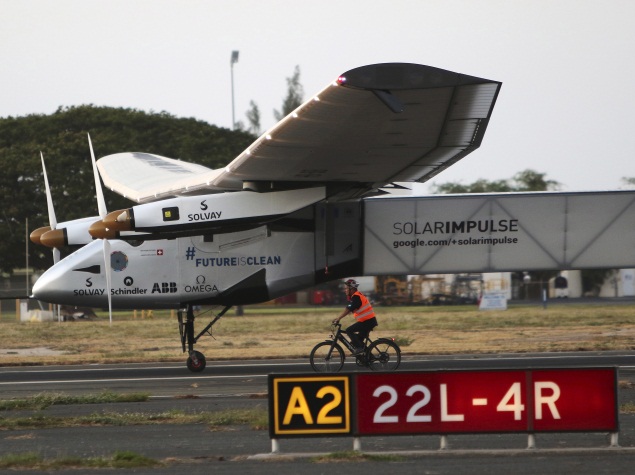- Home
- Science
- Science News
- Solar Impulse 2 Grounded for 9 Months in Hawaii Due to Battery Damage
Solar Impulse 2 Grounded for 9 Months in Hawaii Due to Battery Damage

The spindly, single-seat experimental aircraft dubbed Solar Impulse is not expected to take off on the next leg of its journey - a planned four-day, four-night flight to Phoenix, Arizona - until late April or early May 2016, the team said.
Additional time is needed to repair the plane's four batteries, which store energy from the sun during daylight hours to keep the aircraft powered overnight, allowing it to remain aloft around the clock on extreme long-distance flights.
The repairs and testing will then push the next available window for completing the plane's trans-Pacific crossing to next spring, in terms of both weather conditions and sufficient hours of daylight.
(Also see: Solar Impulse 2 Grounded in Hawaii for Repairs)
The batteries became overheated during the aircraft's initial climb after takeoff on June 29 from Nagoya, Japan, en route to Hawaii on the eighth and most challenging leg of the circumnavigation quest, officials for the mission team said.
The team stressed in a statement that the damage was "not a technical failure or weakness in the technology." Instead, flight managers had miscalculated the temperature increases the plane would experience, and the appropriate amount of insulation required, for the tropical climate encountered on ascent.
Still, the pilot, Swiss aviator Andre Borschberg, and his team successfully completed the Japan-to-Hawaii leg, safely landing near Honoluluon July 3 after five days and five nights, or 117 hours and 52 minutes, airborne.
The trip shattered the 76-hour world duration record for a nonstop, solo flight set in 2006 by the late American adventurer Steve Fossett in his Virgin Atlantic Global Flyer. It also set new duration and distance records for solar-powered flight.
Borschberg and co-founder of the project, fellow Swiss pilot Bertrand Piccard, are aiming to achieve the first round-the-world solar-powered flight, alternating turns at the controls for each leg of the voyage.
The aircraft, about as heavy as a minivan, is propelled by energy collected from 17,000 solar cells that simultaneously recharge the batteries.
The aircraft cruises at an altitude of roughly 28,000 feet (8,500 m) at speeds of 30 to 60 miles (48 to 97 km) an hour. Meditation and hypnosis were part of the pilots' training. They also practice yoga and take 20-minute naps every three hours on extremely long flights.
The team hopes to end its feat in Abu Dhabi, where they started on March 9.
© Thomson Reuters 2015
Catch the latest from the Consumer Electronics Show on Gadgets 360, at our CES 2026 hub.
Related Stories
- Samsung Galaxy Unpacked 2025
- ChatGPT
- Redmi Note 14 Pro+
- iPhone 16
- Apple Vision Pro
- Oneplus 12
- OnePlus Nord CE 3 Lite 5G
- iPhone 13
- Xiaomi 14 Pro
- Oppo Find N3
- Tecno Spark Go (2023)
- Realme V30
- Best Phones Under 25000
- Samsung Galaxy S24 Series
- Cryptocurrency
- iQoo 12
- Samsung Galaxy S24 Ultra
- Giottus
- Samsung Galaxy Z Flip 5
- Apple 'Scary Fast'
- Housefull 5
- GoPro Hero 12 Black Review
- Invincible Season 2
- JioGlass
- HD Ready TV
- Laptop Under 50000
- Smartwatch Under 10000
- Latest Mobile Phones
- Compare Phones
- Samsung Galaxy A07 5G
- Vivo Y500i
- OnePlus Turbo 6V
- OnePlus Turbo 6
- Itel Zeno 20 Max
- OPPO Reno 15 Pro Mini 5G
- Poco M8 Pro 5G
- Motorola Signature
- Lenovo Yoga Slim 7x (2025)
- Lenovo Yoga Slim 7a
- Realme Pad 3
- OPPO Pad Air 5
- NoiseFit Pro 6R
- Xiaomi Watch 5
- Acerpure Nitro Z Series 100-inch QLED TV
- Samsung 43 Inch LED Ultra HD (4K) Smart TV (UA43UE81AFULXL)
- Asus ROG Ally
- Nintendo Switch Lite
- Haier 1.6 Ton 5 Star Inverter Split AC (HSU19G-MZAID5BN-INV)
- Haier 1.6 Ton 5 Star Inverter Split AC (HSU19G-MZAIM5BN-INV)

















